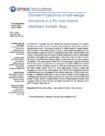Estuaries are the transitional systems between the riverine freshwaters and the ocean salt water. Increasing salt-wedge intrusions are mentioned as one of the major impacts of climate change in coastal areas. We propose a new methodology to predict salt wedge intrusions with an intermediate complexity model, the so-called Estuarine Box Model (EBM), that allows using hydrology and ocean climate scenarios to project the estuarine water exchange which is otherwise unrepresented. We apply this methodology to the Goro branch of the Po river flowing into the Northern Adriatic Sea for both present and future climate conditions. A 30 years’ period (1982-2011) is considered to estimate the salt wedge in the past with the EBM and then we project the salt wedge in the (2021-2050) time period under the RCP8.5 emission scenario. The numerical results show that in the (2021-2050) period, the Po di Goro salt wedge intrusion length will increase by 15% on an annual basis (up to 50% in summertime) and the outflowing salinity will increase 9% on annual basis (up to 35% in summer). Finally, statistical estimations of the extreme values of the salt wedge intrusion length and outflowing salinity show return periods of 10 years (meaning high occurrence probability) for extreme events nearly twice the present mean values. It means that a 16 Km of salt-wedge intrusion and outgoing salinity of about 28 psu are highly expected as an extreme event with 10 years return period.
CMCC InstitutesCMCC Divisions
Authors
- Keywords: climate projections; salt-wedge intrusions; river estuary


